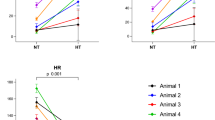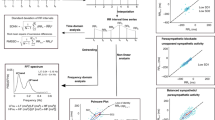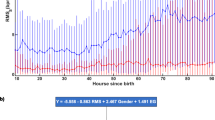Abstract
Objective:
Heart rate variability (HRV) reflects integrity of the autonomic nervous system. However, no study has investigated the impact of therapeutic hypothermia (TH) on HRV measures in infants with hypoxic–ischemic encephalopathy (HIE). In this study, we evaluate the influence of temperature on measures of HRV for a group of infants with favorable outcomes, as compared with a control group of infants with unfavorable outcomes.
Study Design:
Term-born infants with moderate-severe HIE underwent standard TH treatment and prospective electroencephalography (EEG) and electrocardiogram (ECG) recording. Infants with favorable outcome (no seizures, normal/mild EEG scores at 96 h, no magnetic resonance imaging brain injury and normal neurodevelopmental scores at 18 to 24 months) were matched on gestational age, sex and worst encephalopathy score to a group of infants with unfavorable outcomes. Time- and frequency-domain HRV measures were calculated from 60 min of ECG data obtained at three time points: 24 h (hypothermia), 48 h (hypothermia) and 96 h (normothermia). The effect of time and temperature were evaluated using repeated-measures analysis of variance.
Results:
Sixteen infants were included (8 favorable, 8 unfavorable). For both groups of infants, an increase in the HR, RR and HF power was associated with an increase in temperature, but was not associated with any other HRV measure. In contrast, measures of HRV increased over time, as encephalopathy decreased, for infants with favorable outcomes (reflecting increased cortical-autonomic integration), but not for those with unfavorable outcomes.
Conclusions:
In general, the effect of hypothermia on measures of HRV is limited to changes in heart rate (bradycardia) and respiratory rate, as opposed to changes in true variability. This supports the hypothesis that persistent changes in HRV are driven by the underlying brain injury and not by the process of TH.
This is a preview of subscription content, access via your institution
Access options
Subscribe to this journal
Receive 12 print issues and online access
$259.00 per year
only $21.58 per issue
Buy this article
- Purchase on Springer Link
- Instant access to full article PDF
Prices may be subject to local taxes which are calculated during checkout
Similar content being viewed by others
References
Nagai M, Hoshide S, Kario K . The insular cortex and cardiovascular system: a new insight into the brain-heart axis. J Am Soc Hypertens 2010; 4: 174–182.
Volpe JJ . Neurology of the Newborn, 5th edn. Saunders/Elsevier: Philadelphia, 2008.
Azzopardi D, Brocklehurst P, Edwards D, Halliday H, Levene M, Thoresen M et al. The TOBY Study. Whole body hypothermia for the treatment of perinatal asphyxial encephalopathy: a randomised controlled trial. BMC Pediatr 2008; 8: 17.
Shankaran S, Laptook AR, Ehrenkranz RA, Tyson JE, McDonald SA, Donovan EF et al. Whole-body hypothermia for neonates with hypoxic-ischemic encephalopathy. N Engl J Med 2005; 353: 1574–1584.
Jacobs SE, Berg M, Hunt R, Tarnow-Mordi WO, Inder TE, Davis PG. Cooling for newborns with hypoxic ischaemic encephalopathy. In: The Cochrane Collaboration (ed.). Cochrane Database of Systematic Reviews. John Wiley & Sons, Ltd: Chichester, UK, 2013, Available at http://doi.wiley.com/10.1002/14651858.CD003311.pub3 (accessed 23 July 2016).
Tiainen M, Parikka HJ, Mäkijärvi MA, Takkunen OS, Sarna SJ, Roine RO . Arrhythmias and heart rate variability during and after therapeutic hypothermia for cardiac arrest*. Crit Care Med 2009; 37: 403–409.
Li Y, Ristagno G, Guan J, Barbut D, Bisera J, Weil MH et al. Preserved heart rate variability during therapeutic hypothermia correlated to 96 hrs neurological outcomes and survival in a pig model of cardiac arrest. Crit Care Med 2012; 40: 580–586.
Chang Y-T, Wann S-R, Wu P-L, Hsieh K-H, Lin C-C, Huang M-S et al. Influence of age on heart rate variability during therapeutic hypothermia in a rat model. Resuscitation 2011; 82: 1350–1354.
Matthew CB, Bastille AM, Gonzalez RR, Sils IV . Heart rate variability and electrocardiogram waveform as predictors of morbidity during hypothermia and rewarming in rats. Can J Physiol Pharmacol 2002; 80: 925–933.
Rowan WH, Campen MJ, Wichers LB, Watkinson WP . Heart rate variability in rodents: uses and caveats in toxicological studies. Cardiovasc Toxicol 2007; 7: 28–51.
Goulding RM, Stevenson NJ, Murray DM, Livingstone V, Filan PM, Boylan GB . Heart rate variability in hypoxic ischemic encephalopathy: correlation with EEG grade and 2-y neurodevelopmental outcome. Pediatr Res 2015; 77: 681–687.
Massaro AN, Govindan RB, Al-Shargabi T, Andescavage NN, Metzler M, Chang T et al. Heart rate variability in encephalopathic newborns during and after therapeutic hypothermia. J Perinatol 2014; 34: 836–841.
Srinivasakumar P, Zempel J, Trivedi S, Wallendorf M, Rao R, Smith B et al. Treating EEG seizures in hypoxic ischemic encephalopathy: a randomized controlled trial. Pediatrics 2015; 136: e1302–e1309.
Sarnat HB, Sarnat MS . Neonatal encephalopathy following fetal distress. A clinical and electroencephalographic study. Arch Neurol 1976; 33: 696–705.
Scher MS, Aso K, Beggarly ME, Hamid MY, Steppe DA, Painter MJ . Electrographic seizures in preterm and full-term neonates: clinical correlates, associated brain lesions, and risk for neurologic sequelae. Pediatrics 1993; 91: 128–134.
Murray DM, Boylan GB, Ryan CA, Connolly S . Early EEG findings in hypoxic-ischemic encephalopathy predict outcomes at 2 years. Pediatrics 2009; 124: e459–e467.
Srinivasakumar P, Zempel J, Wallendorf M, Lawrence R, Inder T, Mathur A . Therapeutic hypothermia in neonatal hypoxic ischemic encephalopathy: electrographic seizures and magnetic resonance imaging evidence of injury. J Pediatr 2013; 163: 465–470.
Welch P . The use of fast Fourier transform for the estimation of power spectra: a method based on time averaging over short, modified periodograms. IEEE Trans Audio Electroacoustics 1967; 15: 70–73.
Thoresen M, Hellstrom-Westas L, Liu X, de Vries LS . Effect of hypothermia on amplitude-integrated electroencephalogram in infants with asphyxia. Pediatrics 2010; 126: e131–e139.
Stær-Jensen H, Sunde K, Olasveengen TM, Jacobsen D, Drægni T, Nakstad ER et al. Bradycardia during therapeutic hypothermia is associated with good neurologic outcome in Comatose survivors of out-of-hospital cardiac arrest. Crit Care Med 2014; 42: 2401–2408.
Acknowledgements
We acknowledge the tireless efforts of Anthony Barton in the recruitment of participants and his exceptional data management. This work was supported by the following grants: Intellectual and Developmental Disabilities Research Center (IDDRC) at Washington University (NIH/NICHD P30 HD062171), Washington University Institute of Clinical and Translational Sciences KL2 Training Program (NIH/NCATS KL2 TR000450) and Thrasher Foundation.
Author information
Authors and Affiliations
Corresponding author
Ethics declarations
Competing interests
The authors declare no conflict of interest.
Rights and permissions
About this article
Cite this article
Vesoulis, Z., Rao, R., Trivedi, S. et al. The effect of therapeutic hypothermia on heart rate variability. J Perinatol 37, 679–683 (2017). https://doi.org/10.1038/jp.2017.42
Received:
Revised:
Accepted:
Published:
Issue Date:
DOI: https://doi.org/10.1038/jp.2017.42
This article is cited by
-
Improving child health through Big Data and data science
Pediatric Research (2023)
-
Hypothermia and heart rate variability in a healthy newborn piglet model
Scientific Reports (2022)
-
Severity of hypoxic ischemic encephalopathy and heart rate variability in neonates: a systematic review
BMC Pediatrics (2019)
-
Early prognostication of neurological outcome by heart rate variability in adult patients with out-of-hospital sudden cardiac arrest
Critical Care (2019)



